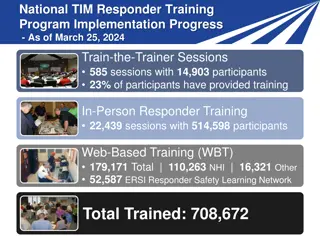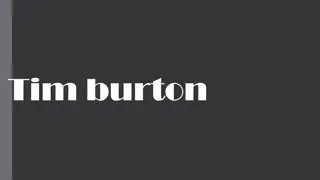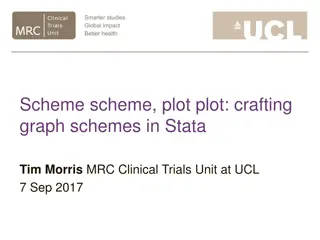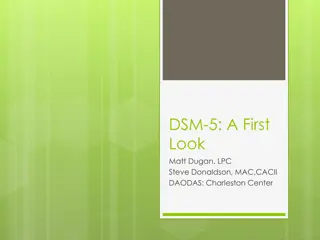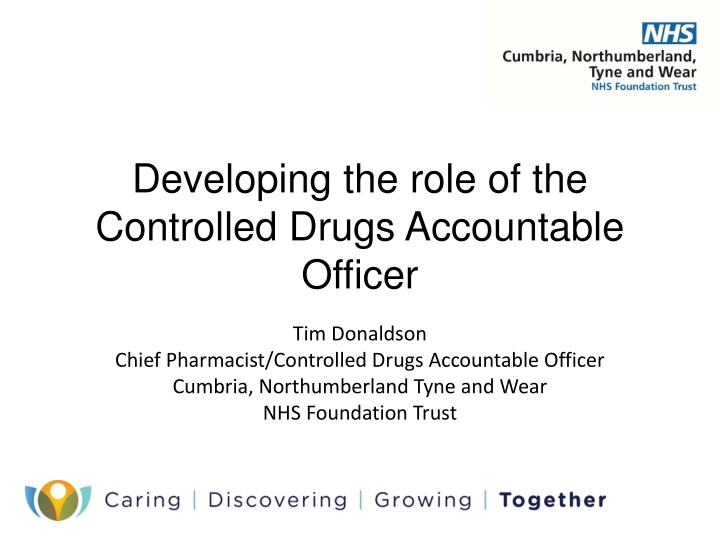
Developing the Role of the Controlled Drugs Accountable Officer - Governance Framework and Responsibilities
Explore the key responsibilities and statutory obligations of the Controlled Drugs Accountable Officer, focusing on ensuring safe management, reporting incidents, and adhering to regulations. Learn about the governance framework, monitoring guidelines, and essential tips for effective CD management.
Download Presentation

Please find below an Image/Link to download the presentation.
The content on the website is provided AS IS for your information and personal use only. It may not be sold, licensed, or shared on other websites without obtaining consent from the author. If you encounter any issues during the download, it is possible that the publisher has removed the file from their server.
You are allowed to download the files provided on this website for personal or commercial use, subject to the condition that they are used lawfully. All files are the property of their respective owners.
The content on the website is provided AS IS for your information and personal use only. It may not be sold, licensed, or shared on other websites without obtaining consent from the author.
E N D
Presentation Transcript
Developing the role of the Controlled Drugs Accountable Officer Tim Donaldson Chief Pharmacist/Controlled Drugs Accountable Officer Cumbria, Northumberland Tyne and Wear NHS Foundation Trust
Cumbria, Northumberland Tyne And Wear NHS FT One of the largest mental health and disability NHS Trusts in England 8920 staff operating from over 100 sites across 4,800 square miles Secondary care services to 1.4m people Regional and national specialist services, including neurological Rated Outstanding by CQC 2016 & 2018
Agenda Setting the scene the governance framework Ensuring adequate time for the role How to get assurance on controlled drugs governance, e.g. policies, procedures and audit Reporting, investigating and closing incidents Monitoring adherence to the NICE Guideline on the Safer Management of Controlled Drugs Top tips Discussion
Statutory Responsibilities Controlled Drugs (Supervision of Management and Use) Regulations 2013 A CDAO of a provider body must establish and operate appropriate arrangements for securing the safe management and use of CDs and to review them as appropriate. To: ensure the safe and effective use and management of CDs within their own organisations and by anybody or person providing services to their organisation ensure monitoring and auditing of the management and use of CDs maintain a record to assess and investigate concerns regarding relevant individuals take appropriate action if there are well-founded concerns establish arrangements for sharing information produce quarterly reports of CD occurrences for the lead CDAO ensure adequate and up to date standard operating procedures (SOPs) are in place in relation to the management and use of CDs ensure relevant individuals receive appropriate information, education or training to ensure adequate destruction and disposal arrangements for CDs
Controlled Drugs Regulations 2013 Regulation 11(3) - CDAOs must ensure they have systems to record concerns (including complaints) and incident reporting systems for untoward incidents which involve the safe management and use of controlled drugs The details of the incident or concern should be recorded and investigated, where appropriate, using locally agreed procedures. The information must continue to be recorded such as on an internal secure database with restricted access It may be that incidents in isolation may not require further investigation but these should still be recorded and stored for future review and to establish whether trends develop Depending on the nature of the incident, CDAOs will need to determine to which other organisations concerns and incidents are reported e.g. NRLS, CDLIN
NICE Guideline: Controlled drugs: safe use and management (NG46) Recommendation 1.4 - Processes for reporting controlled drug-related incidents 1.4.1 When multiple systems (e.g. internal, CDLIN, NRLS) are used for reporting controlled drug-related incidents, consider developing a local process that coordinates these systems within the organisation. This may include: reviewing arrangements regularly to reflect local and national learning carrying out risk assessments of incidents sharing learning 1.4.2 Include in local processes for reporting controlled drug-related concerns or incidents: how to inform the controlled drugs accountable officer or nominated person reporting incidents in a timely way, ideally within 48 hours
NICE Guideline: Controlled drugs: safe use and management (NG46) Recommendation 1.9.3 - Systems for reporting concerns and incidents 1.9.3 Controlled drugs accountable officers must ensure that robust systems are in place for raising and reporting concerns or incidents about controlled drugs in a timely way (including systems for starting investigations) in line with Regulations 11 and Regulation 13 of the 2013 Regulations. This should involve liaising with the following responsible bodies: a designated body Care Quality Commission NHS Counter Fraud Authority Police
NICE Guideline: Controlled drugs: safe use and management (NG46) Recommendation 1.9.4 - Identifying and reporting trends and barriers 1.9.4 NHS England lead controlled drugs accountable officers should consider identifying trends in incidents reported and barriers to reporting. Recommendation 1.9.5 - Reviewing concerns and incidents and sharing information An organisation's controlled drugs accountable officer or nominated person should: review controlled drug-related concerns or incidents and take any action needed on a case-by-case basis share information and learning throughout the organisation from CDLINs
Ensuring adequate time for the role Ensure appropriate lines of accountability Identify process for delegation/escalation Incorporate CDAO role in job description/person spec Identify appropriate support resources operational managers clinical governance patient safety CDLO/police liaison officer CDLIN/Trusted peer support Technical Ensure local practice guidance/SOPs are easily accessible Protect time in weekly schedule/job plan
How to get assurance on controlled drugs governance (1) Use CQC self assessment toolkit CD Governance (SOPs, Audits, etc) Obtaining & receiving CDs Storage Prescribing Dispensing & supply Destruction Transport Controlled stationary Reporting and learning
How to get assurance on controlled drugs governance (2) Promote and support an open learning culture Encourage incident reporting Undertake regular audit/re-audit Report audit findings to both operational and governance committees Identify themes and mitigate risks Stuck improvement actions - engage operational managers/Directors Escalate to Board/CDLIN as appropriate
Reporting, investigating and closing incidents Why report? What to report? What to investigate How to investigate Closing incidents
Why report? A key enabler of CDAO role Meets legal obligations & ensures best practice Protects patients from harm Provides Board and CQC assurance Enables reflection and shared learning Informs development of risk assessments, monitoring systems & audits Identifies clinical practice or persons of concern Supports local investigation of CD occurrences, in association with CDLOs, CFS and CD Local Intelligence Networks
What to include within incident reports? A summary of incident, date, time and location Details of the CD and administration route Impact or likely impact on the health and well-being of the patient(s) Immediate remedial action taken by those involved Whether external agencies have been notified, for example the police or the local authority Outcome of any investigation and any subsequent action (submitted as an update notification) All concerns should be reported immediately to the CDAO
What to investigate (not exhaustive list) Incidents resulting in patient harm Incidents/concerns about alleged or suspected diversion of CDs Alleged of suspected fraudulent activity Unaccounted-for CD losses Concerns about fitness to practice
How to investigate Maintain a contemporaneous record Use local procedure for incident investigation (where available) Undertake data analysis Root cause analysis (RCA) Use locally available experts e.g. LSMS/patient safety team, CDLO, CDLIN Check that appropriate well-being support is being offered to staff under investigation
Closing incidents Identify clear aims & objectives Learning lessons Prevention of diversion Detection of diversion Engage operational managers Named leads for improvement action Agree clear timelines for completion Provide regular updates to Board Report closed when objectives achieved
Monitoring adherence to the NICE Guideline on the Safer Management of Controlled Drugs Use NICE Baseline Assessment toolkit for Controlled Drugs Assess relevance Current evidence/activity? Recommendation met? Required improvement actions? Associated risk (if not implemented)? Cost/saving? Deadline & lead(s) Report findings to Audit Committee/MOC/Board
CHALLENGES & REFLECTIONS TOP TIPS
Top tip #1 Know who you are
Top tip # 2 Assume Nothing It ain t what you know that gets you into trouble. It s what you know for sure that just ain t so Trust is like love - declarations are good,but proof is better Emmanuel Macron Mark Twain
Top tip # 3 Find a Yoda, you must
Thanks for listening Thanks for listening


